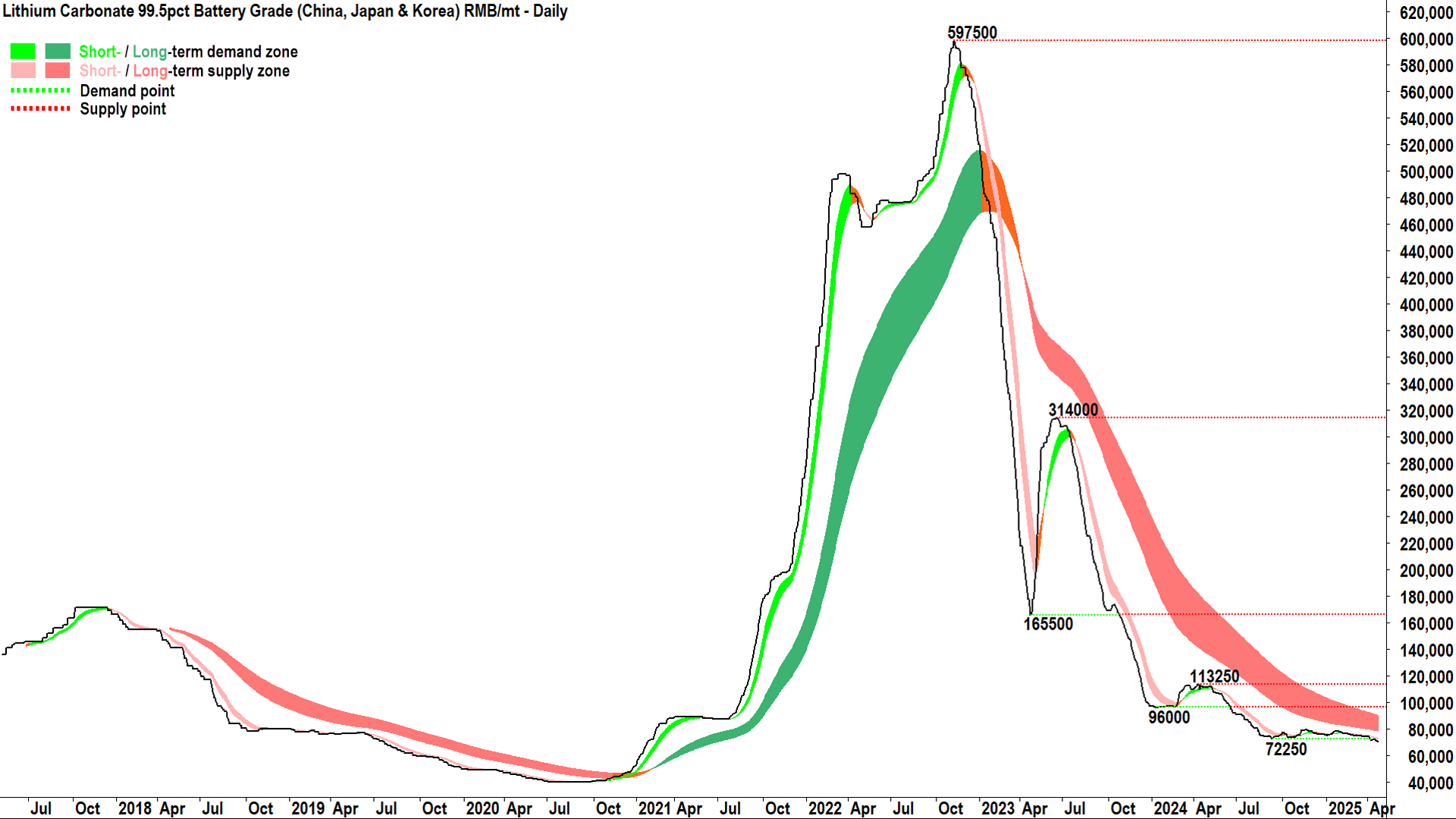Growing lithium supply glut triggers major broker’s new “Short” call: PLS, MIN, LTR on alert
I’ve covered the lithium market closely here and in other media outlets since its meteoric rise immediately following the pandemic, and subsequently, its long and withering decline. As a technical analyst, I have become attuned to spotting the characteristic signals of the typical commodity price cycle: Bust to boom to bust again.
For those who follow my socials, you’ll know that I’ve charted the rise and fall of this curious mineral throughout its last price cycle, calling the top back in 2022, and more recently, tracking its long and steady decline to the present 4-year lows. Just two days ago, I posted the key benchmark lithium carbonate futures contract had logged an all-time low (it has only been around since July 2023).
Given just how bad things are tracking in the sector, it adds even more weight to a new research report from Citi proposing clients take out new short positions in a key lithium contract. My own tracking of broker reports indicates that Citi follows the lithium story closer than most, and I’ve covered their lithium calls several times here on Livewire and on Market Index.
As a background, the broker was generally short and generally correct throughout 2024, only to turn more neutral at the start of this year. At that point, Citi stated it was waiting to assess the market environment around the end of March for signs of rebalancing. Clearly, they didn’t like what they saw.
The firm now advises investors and producers to "sell lithium hydroxide and open a short trade recommendation on the July 2025 CME Lithium Hydroxide futures contract". This article will investigate Citi’s resumed short bias, as well as the key demand and supply side factors impacting the lithium market.
Lithium supply glut: From bad to worse
Even the most ardent lithium bulls would have to concede the major issue facing the lithium market is oversupply. There’s just too much of the various forms of the mineral being produced, and too much of them stockpiled, compared to their present demand.
Sure, that demand is growing, and the hope is eventually it will outweigh supply growth and yield a recovery in the lithium price. But Citi’s latest research suggests lithium bulls will have to hold on in hope a little longer: Current conditions in the lithium market are not temporary or cyclical but symptomatic of a deep structural imbalance between supply and demand.
Citi’s new bearish positioning stems from one critical factor: Oversupply. "We continue to model a large lithium market surplus this year (73kt, 5% of supply) amid demand headwinds and strong supply growth." (Note that the big brokers usually speak in terms of lithium carbonate equivalent (“LCE”) when discussing lithium market demand and supply, so “73kt” is 73kt LCE).
1. Lithium market supply factors
Citi highlights a wave of new capacity coming online from key emerging regions. Production increases from Mali, Argentina, and Brazil are expected to bring an additional 142kt LCE supply in 2025. The restart of the Jianxiawo mine in China, contributing another 36kt LCE, has further delayed rebalancing. The restart of this key “swing-production” mine was likely supported by lower operating costs, local subsidies, and reduced energy prices, giving China even more latitude in pricing power.
Swing producers are those operating very near the marginal cost of production. If a swing producer like Jianxiawo can operate even in the present low-price environment, it implies the marginal cost of production in the entire lithium minerals market has shifted lower – a frightening prospect for higher cost producers.
At the same time, China’s push for upstream lithium self-sufficiency continues. According to Citi, China continues to build domestic upstream capabilities while diversifying its lithium resource base through investments in Africa and Latin America.
A potential wild card in this equation is the Manono hard rock project in Africa, which is not yet included in Citi's supply balances. With potential production of 700ktpa of spodumene concentrate 6% (SC6), equivalent to 105kt LCE, its early arrival could deepen market oversupply significantly.
Citi also notes that some of the world’s better-capitalised miners may also look to accelerate their production timelines to realise scale efficiencies (so they may compete in the present low-price environment). Ironically, all this will serve to do is further lower the global cost curve.
2. Lithium market demand factors
On the demand side, the picture appears equally grim. Trade tensions – particularly between the U.S. and China – are weighing on global lithium-ion cell deployment. Citi notes that "global tariff and trade uncertainty have dampened the outlook for lithium-ion cells (notably for EVs/ESS)", leading to material headwinds for near-term consumption.
In China, a key demand hub, visible inventories of lithium chemicals have climbed to 131kt LCE, suggesting an annualised build-up of around 85kt LCE. While the first quarter of this year saw encouraging signs of stronger cell output (hence Citi’s earlier “neutral” call), post-Chinese New Year restocking demand has been notably muted. Citi also warns of growing downside risk for battery production volumes into the current quarter.
Watch out Lithium: Sodium batteries are coming!
Citi also points out that a potentially disruptive force is emerging in the form of sodium-ion batteries (SIBs), with Chinese battery giant CATL leading the charge. The company has unveiled a new SIB brand, Naxtra, which it intends to mass produce for heavy-duty trucks by June 2025 and passenger electric vehicles by December 2025.
This development poses a serious challenge to lithium’s dominance in battery chemistry, particularly as the lithium market. According to Citi, the performance characteristics of these next-generation sodium batteries are now comparable to lithium-iron phosphate (LFP) batteries, featuring 175Wh/kg energy density, 5C superfast charging, and a range of up to 500km for battery electric vehicles (BEVs).
In addition to performance parity, SIBs offer advantages in safety and cold-weather reliability – factors that could drive adoption in both industrial and consumer transport applications. Citi warns that this shift could result in lithium losing further market share, applying yet more pressure to an already oversupplied sector.
Where are lithium prices headed next?
The logical consequence of an oversupplied market and softening demand is further price compression. “The softening EV/ESS cell outlook and ample lithium supply is likely to force prices lower until mine/converters react,” Citi notes.
The broker’s base case? Eventually, for a return to pre-pandemic price levels of US$5,000–7,000/t for lithium hydroxide. In the short term, over the next three months, though, lithium carbonate and lithium hydroxide should trade to US$7,000/t, and SC6 to US$700/t.
- Lithium Hydroxide: ~25% fall to reach Citi’s target of US$7,000/t.
- Lithium Carbonate: ~27% fall to hit US$7,000/t.
- Spodumene (SC6, CIF China): ~8% fall to reach Citi’s target of US$700/t.
Citi’s latest forecast implies lithium prices still have meaningful room to fall before the market finds a new equilibrium. Further, they mark a dramatic collapse from the 2022 highs – as can be seen in my long term technical analysis chart of lithium carbonate below.
%20RMBmt.png)
Where do Australian SC6 producers PLS, MIN, LTR & IGO sit?
While some lithium producers are attempting to support prices by withholding spodumene offers, such efforts may not be enough to counteract the growing weight of global supply. Australian miners have shown a degree of supply discipline, with several operations placed into care and maintenance, capital expenditure and dividend programs delayed, and future growth plans shelved.
However, Citi cautions this measured approach from local producers is being overwhelmed by strong new supply from regions offering either lower production costs or more importantly – integration into China’s battery manufacturing supply chains.
Also consider that many local producers remain of the mindset that scale will yield lower production costs, and therefore better protection against low-prices. Here, Citi cites local producers like Pilbara Minerals (ASX: PLS), which continues to forge ahead with its major Pilgangoora’s P1000 expansion upgrade, IGO (ASX: IGO) with its Greenbushes expansion, and Liontown Resources (ASX: LTR) with its Kathleen Valley ramp-up, as examples likely to add further volumes to an already saturated market.
Conclusion: Tough times (still) ahead for lithium
Despite prices hovering near what many in the market assumed was the marginal cost of production for the past nine months, a combination of geopolitical uncertainty and new project ramp-ups has made rebalancing in the lithium market elusive.
Citi’s new demand-supply forecast doesn’t see balance returning to the lithium market before 2027 – the full extent of its modelling horizon (as recently as December 2024 they had modelled deficits occurring from 2026).
That’s grim news for Australia’s higher-cost hard rock producers like Pilbara Minerals, Mineral Resources, and Liontown Resources. These companies are now caught in a vice of falling prices and mounting production costs.
The swing factor? China. Clearly, the fate of the lithium market is in China's hands as it is both the major swing producer (and therefore setter of the marginal cost of production), and major consumer. With China's role growing on both the supply and demand sides, the rest of the market may struggle to find equilibrium.
Until prices fall enough to force further shutdowns within Chinese supply chains, or until a genuine resurgence in demand emerges – perhaps driven by policy or unexpected EV growth – the lithium market appears set to remain in oversupply limbo.
As for new projects getting off the ground… Well, the old commodity price cycle is doing its best work again! Citi proposes that many new entrants – especially those ex-China – are likely to face significant hurdles in raising capital for growth projects amid lower valuations and rising uncertainty. Perhaps this lack of “next generation” supply will eventually sow the seeds of the next lithium bull market… In say, ten years? 🤔
This article first appeared on Market Index on Thursday 24 April 2025.

5 topics
4 stocks mentioned
